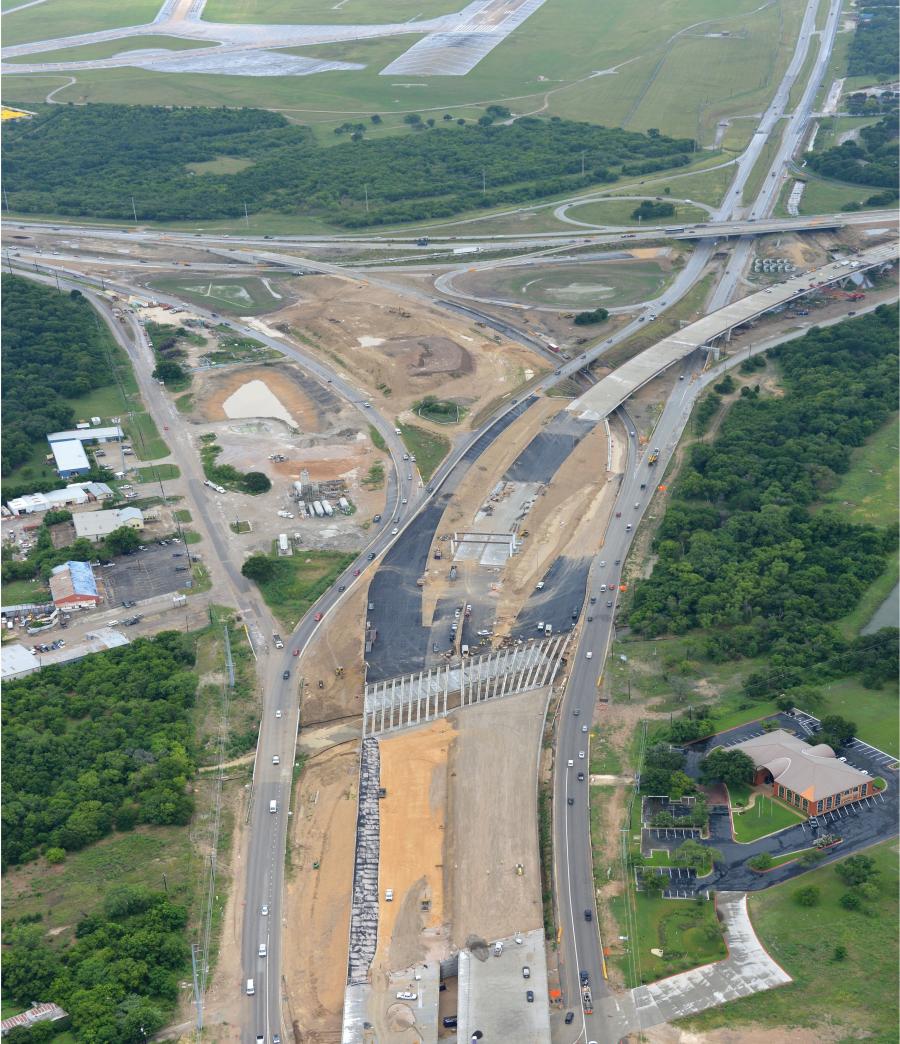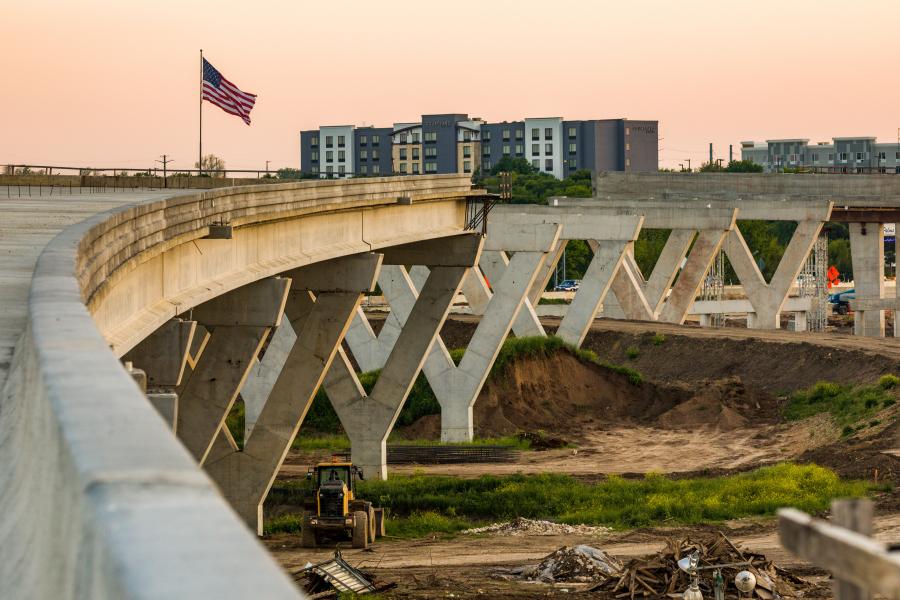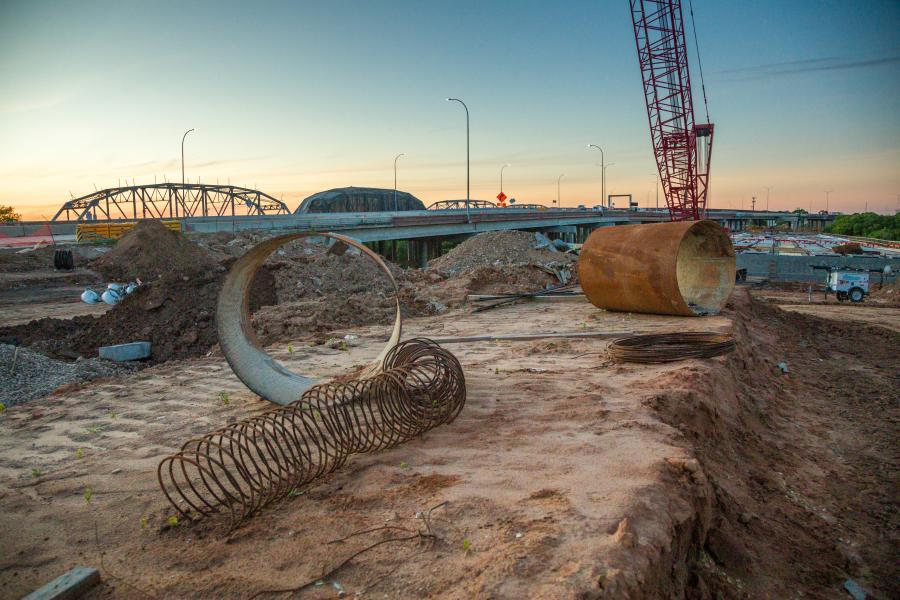Manitowoc cranes have been essential to the project. This crane, the 2250 crawler, deployed at a high point on the project, shows the scope of the major work taking place on the massive construction site.
The Central Texas Regional Mobility Authority's (Mobility Authority) $743 million, 183 South project in Greater Austin will consist of a new tolled expressway with three lanes in each direction on an 8-mi. section of U.S. 183 between U.S. 290 and SH 71. It is being delivered in phases by Colorado River Constructors (CRC), a joint-venture consisting of Fluor Enterprises Inc. and Balfour Beatty Infrastructure Inc.
The Mobility Authority, via the design-build project, also is reconstructing and improving the non-tolled U.S. 183 general purpose lanes (two-to-three lanes in each direction); adding $25 million worth of pedestrian and bicyclist facilities – 16 mi. of bike lanes, 7 mi. of sidewalks and 10 mi. of shared use path with connections to the regional trail system; installing a high tech traffic monitoring system for improved traffic management and emergency response; and upgrades to the visual appearance of the corridor through aesthetic enhancements and landscaping improvements.
The new expressway will serve as a gateway to Austin-Bergstrom International Airport. Phase I (the north end) of the project opened Aug. 1, 2019, and includes the stretch of U.S. 183 from U.S. 290 to Techni Center Drive. Phase II, which includes the southern half of the corridor from Techni Center to SH 71, will open in late 2020.
The project is being done via a partnership with the Texas Department of Transportation, city of Austin, Capital Metro and the Capital Area Metropolitan Planning Organization.
"This will offer Central Texas drivers a non-stop, signal-free route to get to their destination without delay," said CTRMA's Outreach Team Leader Steve Pustelnyk. "This key north-south alternative to I-35 will provide significant improvements to the corridor, including enhanced non-tolled general purpose lanes and new multimodal transportation options in the form of bicycle and pedestrian improvements. It also improves safety, system connectivity, local mobility and travel times, and provides an efficient alternative route to congested local roadways in eastern Travis County."
Design Challenges
As a design-build project, CRC is responsible for both the design and the construction. The design of the portal bents (inverted triangle bents) was a challenge as the base of these bents requires quite a bit of reinforcing steel.
"Special formwork with ‘windows' in them for vibrating concrete around this steel was required," said Justin Word, director of engineering of CTRMA. "Once the vibration is completed, the ‘windows' are closed and the remainder of the bents are poured."
The project required a great deal of utility adjustments as the corridor had many that had to be adjusted.
"This project has been driven by utilities in a major way," said Word. "The utilities along this corridor were planned and installed decades ago with minimal upgrades since. We've completed more than 40 miles of utility renovations overall, closing gaps and optimizing our infrastructure network to meet the needs we are building for with this project."
Equipment
Concrete placed at night has been beneficial because concrete trucks can move throughout the corridor with reduced traffic.
"Reduced traffic levels associated with the COVID-19 pandemic have helped to accelerate certain construction activities and a lot of concrete was poured/placed during the day," said Word. "Moving concrete trucks efficiently through heavy traffic congestion can be a challenge, so we've taken advantage of recent conditions that are more favorable to concrete placement."
The on-site batch plants (a Pugmill Systems 750BTLS and an Erie Strayer Central Mix MG-12CP) minimized travel time to placement sites. Pump trucks were used in isolated areas, predominately on bridge deck pours. Telehandlers were primarily used for material handling and MSE wall panel installation, and placement for concrete paving was done via belt placers (PS2600 and RTP 500) and mixer trucks.
The use of a Manitowoc 2250 crawler crane and a Manitowoc 999 Series 1, 2 and 3 crane throughout the work zone has been instrumental, as have several slipform pavers – a GOMACO Commander III and a GHP-2800 4-track, and an Allen 255CD triple roller tube paver. A large number of Cat and John Deere dozers, Komatsu excavators and compactors/rollers manufactured by Sakai, Wacker, Cat, Hamm and Bomag also have made a difference.
"The large cranes assisted in bridge construction and the slipform pavers were used for concrete pavement placement," said Scott Yardas, CRC's project manager.
More Construction Tasks
During heavy earthwork operations, CRC experienced on-road trucking shortages in central Texas. On-road trucks are needed for excavation and embankment activities, concrete delivery and for delivering wall backfill. This challenge was met by shifting to more off-road trucks and scrapers at certain times throughout the project.
The timeframe for the permitting of water and wastewater adjustments was longer in duration than CRC anticipated, and it re-sequenced work as a result of this delay. Several rainy seasons have posed challenged to CRC's progress with utilities and earthwork activities. The use of cement treated base and a subsequent asphalt bond breaker layer on as many pavement areas as possible helped as it created impervious surfaces that are less impacted by inclement weather than open excavations.
"For any project of this size and scope, careful planning is required from the outset to maintain productivity," said Word. "Demand for skilled labor is consistently high in central Texas – both for transportation and building construction. It's something we prepared for when moving forward with this project. It's also a reason we established a workforce development program through which we strive to connect skilled candidates with positions in the construction industry."
U.S. 183 is one of the major arterials in Austin and the main connection to the airport for many people, which can make moving large loads a challenge during peak traffic times. The phasing prevented the movement of earthwork from one location to the next in the short-term, which led to hundreds of thousands of cubic yards of materials being stockpiled before it could be recycled on-site or re-used on other projects.
The in-situ material in the corridor differs substantially and the pavement section differs substantially throughout the corridor.
"Weather plays a significant role in determining the timelines of phased work, especially during the preparation of the subgrade," said Yardas. "In some areas, this process could be completed as quickly as a week; in other areas it took many weeks. For the concrete pavement, it is more efficient to place concrete in long pulls with the slipform pavers. To accomplish this and increase efficiencies, on-site batch plants were used to support the operation."
Much of the northern half of the bike and pedestrian facilities are completed.
Work on the general-purpose lanes, new tolled lanes and the bike/pedestrian improvements often occurs simultaneously. The tolling gantries are being worked on concurrently with the roadway construction — the gantries have been constructed and the tolling equipment is being installed currently.
"There are ITS elements that will be completed by the end of 2020," said Word. "This includes microwave vehicle detection, closed circuit cameras and digital message signs. Any buried conduit to support any electrical systems was completed in conjunction with the roadway construction. This includes third party utilities and electrical systems to support the tolling and ITS systems."
Overhead LED roadway lighting has been installed.
"Precautions are always necessary to prevent damage when working closely around existing underground infrastructure, such as the underground ITS conduit," said Word.
Up to 450 JV employees and 200 subcontractor (local and regional) employees are on-site.
Materials
A large amount of concrete and steel was garnered from the demolition of 15 bridges, and the excavation generated 178,000 cu. yds. of asphalt, much of which is recycled into the project, and 2.4 million cu. yds. of earth and rock.
As part of the pavement section, there is a predominately 6-in. layer of cement treated base (CTB) made from recycled material. The existing roadway asphalt and base is milled and trucked to an on-site pugmill where it is mixed with water and cement. The CTB product is then incorporated back into the new pavement section.
"Both the Mobility Authority and CRC take pride in minimizing waste and reducing impacts from trucks on local roadways," said Lloyd Chance, senior project manager — construction, of the Mobility Authority. "Any time materials can be recycled back into a project, both costs and carbon footprints are reduced — a win-win."
New materials include more than 600,000 cu. yds. of concrete, 160,000 tons of asphalt and 28,000 tons of steel.
"The team dynamic has been very positive, both with the Mobility Authority and with Atkins, the oversight team," said Yardas. "Being co-located in a shared project office has allowed us to resolve issues quickly and at the appropriate level. Very professional interactions with a ‘what's best for the project' approach. One thing about Texas construction is that the crews are hardworking, team-oriented, and resilient people. They work long hours — days, nights, weekends — in very challenging conditions. All work is outside, where temperatures range from below freezing to well above 100 degrees Fahrenheit and humid."
CRC has three on-site mechanics that are encountering normal wear and tear items such as cutting edges, tires, tracks, hydraulics, along with every day "break-fix" issues.
"Being close to central Austin, common parts are readily available and most repairs occur quickly," said Yardas. "Less common repairs such as conveyor belts, crane parts, etc. take more time as they need to be shipped from other locations."
The keys to maintenance on a long-term project, said Yardas, are "establishing an organized process to communicate needs from operators back to maintenance personnel, daily equipment checklists and feedback to equipment maintenance individuals who then prioritize maintenance efforts, an established maintenance plan for each piece of equipment, basic training of operators to understand daily maintenance and what to look out for on any given machine, and contingency parts — you must have common items stocked on-site to minimize down time and establish quick retrieval from equipment vendors for other parts."
Highway Sustainability
Sustainability has been one of the major priorities and the 183 South Project will be considered for certification by the most widely-used transportation sustainability rating system worldwide — Greenroads. This third-party system evaluates design and construction against a set of criteria, and assigns a rating to truly gauge environmental responsibility.
Sustainable measures have resulted in less noise, intrusive glare and disruptive light pollution; reduced emissions; greater aesthetics and assurance that the project design is reflective of community values.
The project also includes major investments in east Austin such as the restoration of the nationally-recognized historic Montopolis Bridge, which has been decommissioned from vehicular use and will be preserved for bicycle and pedestrian traffic.
All Mobility Authority roads are designed by evaluating projected traffic and travel times for 20 years out and are maintained to provide that improved level of service, bridges and retaining walls are designed to a 75-year lifespan, and drainage culverts for a 75-year lifespan.
Enhancing the corridor's landscape is a priority and nearly 5,000 native, drought-resistant trees will be planted throughout the corridor to reduce water consumption and help prevent soil erosion.
"Native landscaping at key locations helps improve the visual appeal of the corridor," said Pustelnyk. "Working with the community, the project team identified a number of large oak trees that are being nurtured and protected during construction to minimize the risk of loss."
The Mobility Authority has partnered with the non-profit group TreeFolks to promote maintenance and expansion of the urban tree canopy in Austin.
"Through this partnership an additional 10,000 trees have been planted in neighborhood surrounding the project corridor," said Pustelnyk.
Construction has been 24/7 at some locations. Traffic impacts have been considerable, with temporary and permanent lane closures.
"We have incentivized the contractor to plan U.S. 183 mainlane closures during off-peak times when possible, and to complete most traffic-impacting activities at night," said Chance.
The strong Texas economy has caused a surge in both transportation and building construction, which has put a strain on the supply of skilled labor. CRC has able to secure personnel, but it has been a challenge.
The JV purchases and rents equipment from dealerships in the Austin area such as RDO; HOLT Cat; Sunbelt Rentals; H&E Equipment; United Rentals; MG Machinery; Buyers Barricades; Heavy Equipment Rentals of Texas; Waukesha Pearce; Niece Equipment; We Rent It; Longhorn Truck Rentals; AWP; Xylem; TKO Equipment; and ASCO, and regional dealerships: Romco Equipment, First Rentals, Ewald Kubota, N-Line Traffic and Central Texas Equipment.
Most of the dealerships of the larger iron have a strong local presence with technicians and parts in inventory, and warranty and general troubleshooting support has been good for most of the dealers.
"The joint venture has been together working on Texas design/build projects for the better part of 20 years," said Yardas. "We have purchased and leased a significant number of pieces from several Texas dealerships. In doing so we have developed great partnerships with the dealerships and their account representatives. They have learned how we function and adapted their offerings to give us the best price and service available."
Project Background
The U.S. 183 corridor from U.S. 290 to SH 71 is one of Austin's most important arterials.
"Since U.S. 183 was constructed in the mid-1960s, the roadway has been a four-lane divided highway with minor improvements," said Pustelnyk. "As the primary route to and from the airport and points beyond, it attracts more than 60,000 cars and trucks a day. Since 2011, the Mobility Authority and TxDOT have been working with agencies and the community to develop a reasonable and feasible approach to improving mobility in the U.S. 183 South corridor to reduce travel times and improve quality of life. As traffic congestion has increased, quality of life in adjacent neighborhoods has become increasingly impacted and travel times to the airport have become unpredictable."
Planning for the project started in 2011 with an environmental study. Crews broke ground in April 2016 on the two-phase project. To fund the project, the Mobility Authority issued toll revenue bonds in the amount of $252.2 million, the Federal Government provided a $282.2 million loan under the Transportation Infrastructure Finance and Innovation Act and TxDOT provided loans totaling $60 million plus and a one-time grant of $146.3 million to help fund the non-tolled elements.
Equipment Used
Excavators
- Cat 374s, 349s and 320s;
- Komatsu PC210s, PC228s, PC308s, PC360s and PC490s;
- John Deere 245Gs.
Dozers
- Cat D3Ks, D4Ks and D6Ts;
- John Deere 550Ks and 750Ks.
Loaders
- Cat 938Ms and 950Ms;
- John Deere 624Ks, 644Ks and 744Ks;
- Komatsu WA270s and WA320s;
- GOMACO GP2800s, RTP500s, PS2600s, TC5600s and TC600.
Pavers/Rollers
- Sakai SV540 pads, SV540 smooths and SV640 smooths;
- Cat CW34s and 815Ks;
- Wacker Neuson RD12As;
- Hamm 54-in. pad;
- Dynapac CT3000;
- Genie manlifts – S-60Xs, S-80Xs and S-65s. CEG
Irwin Rapoport
A journalist who started his career at a weekly community newspaper, Irwin Rapoport has written about construction and architecture for more than 15 years, as well as a variety of other subjects, such as recycling, environmental issues, business supply chains, property development, pulp and paper, agriculture, solar power and energy, and education. Getting the story right and illustrating the hard work and professionalism that goes into completing road, bridge, and building projects is important to him. A key element of his construction articles is to provide readers with an opportunity to see how general contractors and departments of transportation complete their projects and address challenges so that lessons learned can be shared with a wider audience.
Rapoport has a BA in History and a Minor in Political Science from Concordia University. His hobbies include hiking, birding, cycling, reading, going to concerts and plays, hanging out with friends and family, and architecture. He is keen to one day write an MA thesis on military and economic planning by the Great Powers prior to the start of the First World War.
Read more from Irwin Rapoport here.
Today's top stories

























